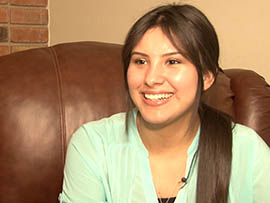Cronkite News has moved to a new home at cronkitenews.azpbs.org. Use this site to search archives from 2011 to May 2015. You can search the new site for current stories.
Expansion makes deferred-action program more available in Arizona
PHOENIX – Laura Reyes was 6 when she came to the United States illegally along with her brother and sister.
Because she then went back to Mexico and returned later than 2007, she didn’t qualify for the first version of the Obama administration’s Deferred Action for Childhood Arrivals program. But with the requirements changing as of Feb. 18 so that those in the country after Jan. 1, 2010, are eligible, Reyes can apply for a three-year work permit that she said will allow her to go to college when she finishes high school.
“When I heard about the new requirements, I was really happy,” Reyes said. “I plan on going to the immigration office on Feb. 18 and turning in my application. I want to finish school and then become a social worker.”
The DACA program, offered by United States Citizenship and Immigration Services (USCIS), also is allowing more people to qualify by removing a cap on age – applicants had been required to be no older than 31 as of June 15, 2010. It also is lengthening work permits from two to three years.
Applicants still must have entered the country before they reached age 16.
Magaly Fontes, an immigration attorney in Phoenix, said the new DACA requirements allow those who wish to get work permits to “prove less and get more.”
“Many people couldn’t prove that they had continuous physical presence from 2007 to 2014,” she said. “Now they only have to show physical presence from 2010 to the present day.”
Since President Barack Obama created the program in 2012, 21,625 Arizona immigrants have had their applications accepted, and 18,981 of those applications have been approved, according to the USCIS website.
Carlos Vélez-Ibáñez, regents’ director at Arizona State University’s School of Transborder Studies, estimates that half of the state’s residents of Mexican origin population are older than the previous age restriction. He said people in this group can come “out of the shadows,” get better jobs and pay taxes.
“These people can now live an American civil life,” Vélez-Ibáñez said.
Alondra Lopez, a student at Glendale Community College, said she wouldn’t have been able to apply under the previous DACA guidelines because she left the country in 2008. The oldest of six siblings, Lopez is the only one of them to not have U.S. citizenship, she said.
“It’s (DACA) going to be so beneficial for me in so many ways,” Lopez said. “First of all, I will be able to get my driver’s license, become more independent, and from there start working. I will be able to help my parents in whatever they need as well and, most importantly, my education.”
Lopez said she would like to attend the Grand Canyon University someday and become a biology teacher, but for now she said she’s grateful for the opportunity to apply for the DACA program.
“It’s time to take advantage of it and be thankful for everybody that supported immigration reform.”
EDITOR’S NOTE: Cronkite News reporter Brenda Carrasco contributed to this report.







